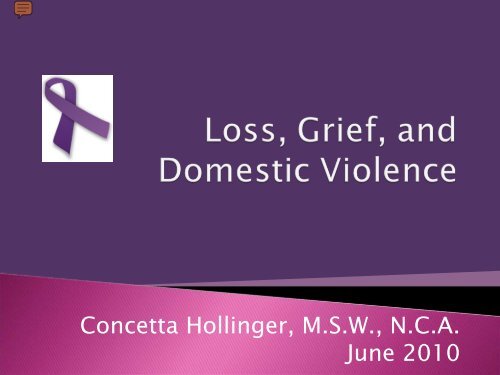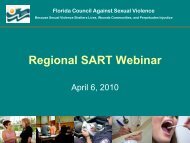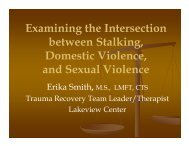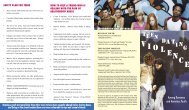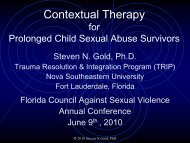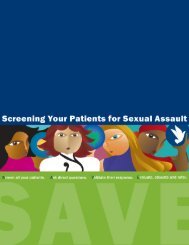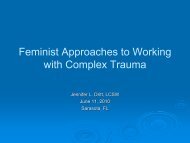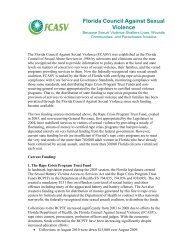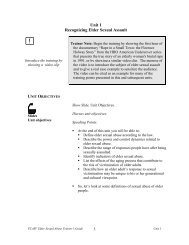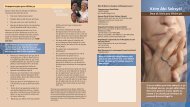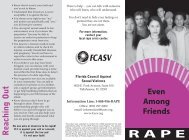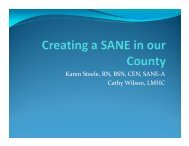Loss, Grief, and Domestic Violence - Florida Council Against Sexual ...
Loss, Grief, and Domestic Violence - Florida Council Against Sexual ...
Loss, Grief, and Domestic Violence - Florida Council Against Sexual ...
Create successful ePaper yourself
Turn your PDF publications into a flip-book with our unique Google optimized e-Paper software.
Concetta Hollinger, M.S.W., N.C.A.<br />
June 2010
Usually when society thinks of grief, it is thought of<br />
revolving around the death of a loved one… a<br />
physical being..a physical loss<br />
…as we have come to experience so many other<br />
types of loss in our lives, society has begun to<br />
underst<strong>and</strong> grief differently through the recognition<br />
of losses that are not death related…<br />
survivors of domestic violence are grieving for<br />
multiple losses, many of which still go<br />
unrecognized <strong>and</strong> unacknowledged.
…<strong>Loss</strong><br />
<strong>Grief</strong><br />
<br />
…Bereavement<br />
<br />
Mourning…?
Bereavement<br />
◦ The actual event of a significant loss<br />
<strong>Loss</strong><br />
◦<br />
◦<br />
◦<br />
◦<br />
◦<br />
◦<br />
◦<br />
◦<br />
◦<br />
◦<br />
Death<br />
Divorce<br />
Separation<br />
End of Significant Relationships<br />
Employment <strong>Loss</strong><br />
Independence<br />
Property <strong>Loss</strong><br />
Miscarriage<br />
Infertility<br />
Adoption
<strong>Grief</strong> is the actual expression of the loss<br />
◦<br />
◦<br />
◦<br />
◦<br />
Physical<br />
Emotional<br />
Behavioral<br />
Psychological/Cognitive<br />
“First we are bereaved, then we<br />
grieve…”
The more or less conventional<br />
institutionalized expressions of grief (Doka,<br />
2002 as defined by Maris)<br />
Observable expression of grief (Doka, 2002<br />
as defined by Parkes <strong>and</strong> Weiss)<br />
Cultural or public displays of grief (i.e.,<br />
viewings, memorials, funerals, obituaries,<br />
clothing worn, etc.)
“Mourning consists of social<br />
expectations as well as cultural<br />
definitions <strong>and</strong> rules that tell us<br />
how important our loss is whether<br />
we have the right to grieve; <strong>and</strong> if<br />
so, how much, how long, <strong>and</strong> in<br />
what ways we can <strong>and</strong> should do<br />
this.”<br />
(Doka, 2002)
Mourning<br />
◦<br />
The process by which we integrate loss <strong>and</strong> grief<br />
into our lives<br />
Adaptation<br />
Mobilization<br />
Reintegration<br />
Finding Meaning<br />
The process of mourning may be influenced<br />
or guided by cultures, religions, society,<br />
<strong>and</strong> rituals.
Emotional Reactions<br />
◦<br />
◦<br />
◦<br />
◦<br />
◦<br />
◦<br />
◦<br />
◦<br />
◦<br />
◦<br />
◦<br />
◦<br />
Numbness<br />
Shock<br />
Disbelief <strong>and</strong> Denial<br />
Sadness<br />
Guilt<br />
Yearning<br />
Despair<br />
Hopelessness<br />
Feeling lost<br />
Anger<br />
Bitterness<br />
Relief<br />
<br />
Physical Reactions<br />
◦<br />
◦<br />
◦<br />
◦<br />
◦<br />
◦<br />
◦<br />
◦<br />
◦<br />
◦<br />
◦<br />
◦<br />
Deep sighing<br />
Weakness <strong>and</strong> fatigue<br />
Rapid heartbeat<br />
Increased blood pressure<br />
Decrease in activity<br />
Changes in sleeping patterns<br />
Neglect of self care<br />
Increased sensory awareness<br />
Decreased immune system<br />
Weight <strong>and</strong> appetite changes<br />
Muscular tension<br />
Nausea or vomiting
Cognitive Reactions<br />
◦<br />
◦<br />
◦<br />
◦<br />
◦<br />
◦<br />
◦<br />
◦<br />
◦<br />
◦<br />
Changes in dream patterns<br />
Flashbacks<br />
Continuous<br />
thoughts/memories<br />
Intrusive<br />
thoughts/memories<br />
Triggers that cause<br />
emotional, behavioral, or<br />
physical reactions<br />
Spiritual Conflicts<br />
Startle reactions<br />
Absentmindedness<br />
“Lost” portions of<br />
times/events<br />
Dissociation<br />
<br />
Behavioral Reactions<br />
◦<br />
◦<br />
◦<br />
◦<br />
◦<br />
◦<br />
◦<br />
◦<br />
◦<br />
◦<br />
◦<br />
Blaming others<br />
Apathetic regarding<br />
activities<br />
Preoccupied<br />
Crying<br />
Seeking solitude<br />
Seeking Forgiveness<br />
Detachment<br />
Isolation<br />
Disorientation<br />
Withdraw from<br />
family/friends<br />
Unable to concentrate
Defined as…<br />
◦ A pattern of behaviors utilized to<br />
obtain control <strong>and</strong> domination over<br />
an intimate partner or family<br />
member (i.e., over another person)<br />
Assaultive<br />
Coercive<br />
Controlling<br />
Manipulation
Legally defined as…FS 741.28(1)<br />
◦<br />
Any abusive of one family member or<br />
household member by another family or<br />
household member<br />
<br />
<br />
<br />
Persons related by blood or through marriage<br />
Persons who share a child in common<br />
Persons who reside together, or who have resided<br />
together in the past, as a family unit
Family <strong>Violence</strong><br />
Intimate Partner <strong>Violence</strong><br />
<strong>Domestic</strong> <strong>Violence</strong><br />
Dating <strong>Violence</strong><br />
Relationship <strong>Violence</strong>
Power<br />
Control<br />
Domination<br />
Manipulation<br />
Coercion<br />
<br />
<br />
<br />
<br />
<br />
<br />
Verbal<br />
Physical<br />
<strong>Sexual</strong><br />
Emotional<br />
Psychological<br />
Financial/Economic
Changes in eating<br />
patterns<br />
Changes in sleeping<br />
patterns<br />
Nightmares<br />
Flashbacks<br />
Body fatigue/Exhaustion<br />
Crying<br />
Changes in thinking<br />
patterns<br />
Body fatigue<br />
Numbness<br />
<br />
<br />
<br />
<br />
<br />
<br />
<br />
<br />
Nausea/Vomiting<br />
Inability to concentrate<br />
Physical shock<br />
Emotional shock<br />
Spiritual Conflicts<br />
“Cycling” of emotions<br />
Changes in<br />
interpersonal<br />
relationships<br />
Triggers that send the<br />
body into emotional or<br />
physical reactions
Emotional Responses<br />
Physical Distress<br />
Cognitive Reframing<br />
Conditioning/Conditioned Responses<br />
Behavioral Adjustments<br />
◦<br />
◦<br />
◦<br />
Coping Skills<br />
Defense Mechanisms<br />
Adaptive or Maladaptive
In 2006, crimes by intimate partners<br />
accounted for 12% of all violent crime (Bureau<br />
of Justice Statistics, 2007)<br />
Approximately 1 in 5 high school girls has<br />
reported being abused by a boyfriend<br />
(Silverman, et al., 2001)
25% of women will experience domestic<br />
violence at some point in their lives (<strong>Florida</strong><br />
Coalition <strong>Against</strong> <strong>Domestic</strong> <strong>Violence</strong>,<br />
www.fcadv.org/statistics )<br />
In 2006, lesbians, gay, bisexual, or<br />
transgender people experienced 3, 534<br />
incidents of domestic violence (National<br />
Coalition of Anti- <strong>Violence</strong> Program, 2007)
One study found that women who had<br />
experienced any type of personal violence,<br />
even when the last episode was 14-30 years<br />
ago, reported a greater number of chronic<br />
physical symptoms than those who had not<br />
been abused.<br />
◦<br />
The risk of suffering from 6 or more chronic<br />
physical symptoms increased with the number of<br />
forms of violence experienced (Nicolaidis, et al.,<br />
2004)
50% of all stalking cases involve current of<br />
previous intimate partners (Tjaden <strong>and</strong><br />
Thoennes, 1998)<br />
The prevalence of anxiety, stalking, insomnia,<br />
social dysfunction, <strong>and</strong> severe depression is<br />
much higher among stalking victims than the<br />
general population (Blaauw, 2002)
In 2006, child protective services found<br />
approximately 905,000 children to be victims<br />
of child abuse or neglect (Child Maltreatment,<br />
2008)<br />
The most significant predictor of whether or<br />
not a battered woman will physically abuse<br />
her children is having been physically abused<br />
by her own mother, not whether she has been<br />
battered by her partner (Coohey, 2004)
Of the alleged perpetrators of elder abuse in<br />
2004, 33% percent were adult children; 22%<br />
were other family members; <strong>and</strong> 11% were<br />
spouses or intimate partners; the remaining<br />
had unknown relationships (Teaster et al.,<br />
2004)
For what<br />
might they be grieving??
Independence<br />
Security<br />
Intimate Relationship<br />
Support of Family <strong>and</strong> Friends<br />
Social Networks<br />
Hope<br />
Belief Systems<br />
Trust<br />
The Happy Ending
The parent they were supposed to be<br />
The life your children were supposed to<br />
live<br />
The future that you will have in an<br />
abusive relationship<br />
The future you expected to have<br />
The way it was<br />
The way you wish it had been
The person you thought they were<br />
The person you expected them to be<br />
The relationship you deserved to have<br />
The life you were supposed to lead<br />
The person that you were before the<br />
abuse<br />
The person you wish you had been the<br />
first time the abuse happened
◦<br />
Actual victimization event <strong>and</strong> all that may have<br />
come after that -<br />
The first time…<br />
The next time…<br />
The last time…<br />
The next time after the last time…<br />
When you stay…<br />
When you leave…
<strong>Grief</strong> which is:<br />
◦<br />
◦<br />
◦<br />
Not openly acknowledged<br />
Not socially validated<br />
Not publicly observed<br />
The person has no socially<br />
accorded right to grieve that loss<br />
or to mourn in that particular way.
Lack of recognition of the relationship<br />
Lack of acknowledgement of the loss<br />
Exclusion of the griever<br />
Circumstances of the death/loss<br />
Ways individuals grieve
The Kubler-Ross Model
Shock, disbelief,<br />
disorientation<br />
Minimizes the<br />
situation<br />
Deflects questions<br />
Other topics are<br />
weighted with<br />
greater importance<br />
<strong>and</strong> concern<br />
<br />
<br />
<br />
<br />
Withdraws /Isolates<br />
Does not actively<br />
utilize support<br />
system<br />
Lacks self-empathy<br />
Perception of<br />
wellness, happiness,<br />
confidence, etc.
“Anger, rage, envy,<br />
resentment”<br />
“Why me?”<br />
Adrenaline/Energy<br />
◦ Motivation<br />
<br />
<br />
<br />
Displacement<br />
Grievances<br />
Healthy expression<br />
<strong>and</strong> outlets<br />
◦<br />
◦<br />
Boundaries<br />
Assertiveness
In grief:<br />
◦<br />
◦<br />
A way to postpone<br />
Often made with “God”<br />
In victims of domestic violence dealing with<br />
grief:<br />
◦<br />
◦<br />
Impedes on security<br />
Provides an opportunity to elicit information about<br />
how the client may have wished to change
Sadness<br />
When the greatness of the loss sinks in<br />
“Depression is anger turned inwards”<br />
Secondary victimizations
Not “happiness”<br />
Acknowledgement/Recognition<br />
Incorporation into life experiences <strong>and</strong> life<br />
story<br />
Finding meaning<br />
Integration of meaning
Self-blame<br />
Shame<br />
Inward expressions<br />
“Along with guilt, in came her friends shame<br />
<strong>and</strong> embarrassment”
Peace<br />
Joy<br />
Respite<br />
Liberation
What are the goals of crisis intervention?
Specific steps which must be taken if a person is<br />
to be freed from the attachment to the [loss]<br />
(Lindemann)<br />
The psychological process of adjustment to the<br />
loss (Maris)<br />
The process of grieving is the reconstruction of<br />
meaning (Neimeyer)<br />
Getting in touch with <strong>and</strong> expressing the natural<br />
emotions (Kubler-Ross)
• Client Directed<br />
• Facilitated <strong>and</strong> supported by<br />
advocate<br />
• Interventions for healing<br />
• Don’t idolize the violence or<br />
abusive relationship<br />
• Recognize <strong>and</strong> acknowledge the<br />
loss
Rituals of Continuity<br />
◦ Ongoing presence of the loss<br />
Rituals of Transition<br />
◦ Mark or change movement since the loss<br />
Rituals of Reconciliation<br />
◦ Complete unfinished business or<br />
offer/accept forgiveness*<br />
Rituals of Affirmation<br />
◦ Affirm the loss, recognize lessons learned in the<br />
experience
Allow clients to carefully consider the implications of<br />
the actions that are about to be undertaken<br />
Offer options<br />
Empower the client to make choices<br />
Thoroughly process the ritual once it is complete<br />
Effective rituals tend to have visible elements that<br />
also have symbolic significance<br />
Should not intrude or complicate the grieving process
Do not allow the client (or yourself) end in a<br />
position where the violence or the relationship<br />
becomes idolized<br />
Stay realistic about the violence, focus on the<br />
losses incurred<br />
◦<br />
◦<br />
◦<br />
And how the grief relates to those losses<br />
This may include the experience of abuse<br />
How the violence impacts the grieving process<br />
Use ritual as a method for acknowledging <strong>and</strong><br />
recognizing the grief experience
• Write an obituary/eulogy for…<br />
• Write a letter of ____ to ____….(earlier self,<br />
children, family, friends –<br />
whatever is<br />
reoccurring in the client’s sessions)<br />
• Shred, burn afterwards as a way<br />
• of letting go<br />
• Draw a headstone<br />
• Write a letter to the future self<br />
• Empty Chair exercise
•Provide psychoeducational sessions<br />
•Facilitate the expression of emotions<br />
related to the losses<br />
•Validate <strong>and</strong> Normalize Reactions<br />
•Allow clients to explore the effects of<br />
the change on their own sense of self<br />
<strong>and</strong> their beliefs<br />
•Identify adaptive <strong>and</strong> maladaptive<br />
coping skills
•Legitimizing the grief process/role of<br />
the griever<br />
•Reviewing <strong>and</strong> creating support<br />
system<br />
•Using rituals as interventions for<br />
healing<br />
•Allow clients to develop their own<br />
rituals for acknowledging the loss<br />
•Help clients realistically plan for the<br />
future
• Incorporate the topic of loss,<br />
grief, grief work, <strong>and</strong> mourning<br />
• Have group create a<br />
ritual/expression of their grief<br />
work<br />
• Incorporate both grief <strong>and</strong><br />
disenfranchised grief
NASH<br />
Natural, Accidental, Suicide, Homicide
Homicide<br />
The loss of a life<br />
A bereaved family<br />
<strong>Grief</strong> over the life of a loved one<br />
Mourning the life lived in violence, the life<br />
that should have been, <strong>and</strong> the life lost<br />
through domestic violence
Statistical Overview<br />
Bureau of Justice Statistics (2007) “Criminal Victimization in the United States:<br />
Statistical Tables,” Washington, DC: Bureau of Statistics, 2007<br />
Silverman, Jay et al. (2001) “Dating <strong>Violence</strong> <strong>Against</strong> Adolescent Girls <strong>and</strong><br />
Associated Substance Use, Unhealthy Weight Control, <strong>Sexual</strong> Risk Behavior,<br />
Pregnancy, Suicidality<br />
<strong>Florida</strong> Coalition <strong>Against</strong> <strong>Domestic</strong> <strong>Violence</strong>, www.fcadv.org/statistics<br />
National Coalition of Anti-<strong>Violence</strong> Programs (2007) “Lesbian, Gay, Bisexual, <strong>and</strong><br />
Transgender <strong>Domestic</strong> <strong>Violence</strong>”<br />
Nicolaidis, Christina et al. (2004) “<strong>Violence</strong>, Mental Health, <strong>and</strong> Physical symptoms<br />
in an Academic Internal Medicine Practice”<br />
Tjaden, Patricia & Thoennes, Nancy (1998) “Stalking in America: Findings from the<br />
National <strong>Violence</strong> against Women Survey”<br />
Blaauw, Eric. et al., “The Toll of Stalking” Journal of Interpersonal <strong>Violence</strong><br />
Child Maltreatment (2006) “U.S. Department of Health <strong>and</strong> Human Services,<br />
Administration on Children, Youth, <strong>and</strong> Families<br />
Coohey, Carol (2004) “Battered Mothers Who Physically Abuse Their Children”<br />
Journal of Interpersonal <strong>Violence</strong> 19, no. 8<br />
Teaster, Pamela (2004) “The 2004 Study of Adult Protective Services”
Disenfranchised <strong>Grief</strong><br />
Ed. Doka, Ken (2002) Disenfranchised <strong>Grief</strong>: New Directions, Challenges, <strong>and</strong><br />
Strategies for Practice. Research Press: Champaign, IL, pages 5-6<br />
Ed. Doka, Ken (2002) Disenfranchised <strong>Grief</strong>: New Directions, Challenges, <strong>and</strong><br />
Strategies for Practice. Research Press: Champaign, IL, page 10<br />
Mourning<br />
Ed. Doka, Ken (2002) Disenfranchised <strong>Grief</strong>: New Directions, Challenges, <strong>and</strong><br />
Strategies for Practice. Research Press: Champaign, IL, page 30<br />
Ed. Doka, Ken (2002) Disenfranchised <strong>Grief</strong>: New Directions, Challenges, <strong>and</strong><br />
Strategies for Practice. Research Press: Champaign, IL, page 24<br />
Stages of <strong>Grief</strong><br />
Kubler-Ross, Emily (2003) On Death <strong>and</strong> Dying. Scribner: New York, NY, page 63<br />
<strong>Grief</strong> Work<br />
Ed. Doka, Ken (2002) Disenfranchised <strong>Grief</strong>: New Directions, Challenges, <strong>and</strong><br />
Strategies for Practice. Research Press: Champaign, IL, page 24


